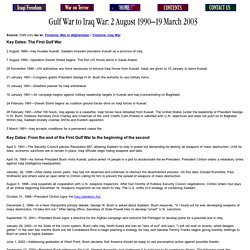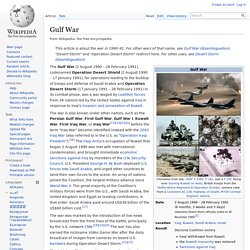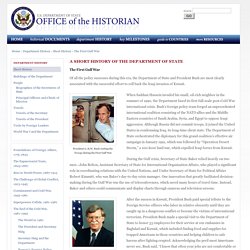

Timeline Two Gulf Wars. Key Dates: The First Gulf War 2 August 1990—Iraq invades Kuwait.

Saddam Hussein proclaims Kuwait as a province of Iraq. 7 August 1990—Operation Desert Shield begins. The first US forces arrive in Saudi Arabia. 29 November 1990—UN authorizes any force necessary to remove Iraqi forces from Kuwait. 21 January 1991—Congress grants President George H.W. 15 January 1991—Deadline passes for Iraqi withdrawal. 16 January 1991—Air campaign begins against military leadership targets in Kuwait and Iraq (concentrating on Baghdad). 24 February 1991—Desert Storm begins as coalition ground forces drive on Iraqi forces in Kuwait. 28 February 1991—After 100 hours, Iraq agrees to a ceasefire. 3 March 1991—Iraq accepts conditions for a permanent cease fire. Iraq ready to restart oil production as OPEC meets - Jul. 3, 2001. LONDON (CNN) - Iraq says it is set to resume pumping oil after the U.S. and Britain abandoned a bid to bring in "smart" sanctions against it.

Baghdad ceased oil production under the United Nations-supervised oil-for-food programme last month in protest at attempts by the U.S. and UK to alter the 11-year-old Gulf War embargo. Britain and America on Monday dropped their proposal, which called for the plugging of lucrative Iraqi oil smuggling routes and tightening of the arms embargo against Baghdad, after Russia threatened to veto the idea at a U.N. meeting. Invasion of Kuwait. The Invasion of Kuwait, also known as the Iraq–Kuwait War, was a major conflict between Ba'athist Iraq and the Emirate of Kuwait, which resulted in the seven-month-long Iraqi occupation of Kuwait, and subsequently led to direct military intervention by US-led forces in the Gulf War and the setting alight by Iraq of 600 Kuwaiti oil wells.

Dispute over the financial debt[edit] When the Iran-Iraq War broke out, Kuwait initially stayed neutral and also tried mediating between Iran and Iraq. [citation needed] In 1982, Khomeini openly attempted exporting the Iranian Revolution to Kuwait. [citation needed] As a result, Kuwait supported Iraq in order to prevent Iranian hegemony in Kuwait. Gulf War. The Gulf War (2 August 1990 – 28 February 1991), codenamed Operation Desert Shield (2 August 1990 – 17 January 1991), for operations leading to the buildup of troops and defense of Saudi Arabia and Operation Desert Storm (17 January 1991 – 28 February 1991) in its combat phase, was a war waged by coalition forces from 34 nations led by the United States against Iraq in response to Iraq's invasion and annexation of Kuwait.

The First Gulf War - Short History - Department History - Office of the Historian. The First Gulf War Of all the policy successes during this era, the Department of State and President Bush are most clearly associated with the successful effort to roll back the Iraqi invasion of Kuwait.

President G. H.W. Bush visiting the Troops during the First Gulf War When Saddam Hussein invaded his small, oil-rich neighbor in the summer of 1990, the Department faced its first full-scale post-Cold War international crisis. During the Gulf crisis, Secretary of State Baker relied heavily on two men—John Bolton, Assistant Secretary of State for International Organization Affairs, who played a significant role in coordinating relations with the United Nations, and Under Secretary of State for Political Affairs Robert Kimmitt, who was Baker’s day-to-day crisis manager.
Assistant Secretary of State for International Organization Affairs, John Bolton. Sanctions against Iraq. The sanctions against Iraq were a near-total financial and trade embargo imposed by the United Nations Security Council on the Iraqi Republic.

They began August 6, 1990, four days after Iraq's invasion of Kuwait, stayed largely in force until May 2003 (after Saddam Hussein's being forced from power),[1] and persisted in part, including reparations to Kuwait, through the present.[2][3][4] The original stated purposes of the sanctions were to compel Iraq to withdraw from Kuwait, to pay reparations, and to disclose and eliminate any weapons of mass destruction. Goals[edit] Resolutions 661 and 687 expressed the goals of eliminating weapons of mass destruction and extended-range ballistic missiles, prohibiting any support for terrorism, and forcing Iraq to pay war reparations and all foreign debt.[5][6] Some have argued that a non-expressed goal of the sanctions was the removal of Saddam Hussein. Administration[edit] Limitations on imports[edit] Allocation of export proceeds[edit] U.S. Conspiracy to Initiate the War Against Iraq.
Even before the first day of the Persian Gulf crisis George Bush and the Pentagon wanted to wage war against Iraq.

What was the character of this war? Iraq neither attacked nor threatened the United States. We believe that this was a war to redivide and redistribute the fabulous markets and resources of the Middle East, in other words this was an imperialist war. The Bush administration, on behalf of the giant oil corporations and banks, sought to strengthen its domination of this strategic region. It did this in league with the former colonial powers of the region, namely Britain and France, and in opposition to the Iraqi people's claim on their own land and especially their natural resources. We didn't find anything of that sort [i.e. comparable to the U.S. buildup] anywhere in Kuwait. On September 18, 1991, only a week after the Soviet photos were taken, the Pentagon was telling the American public that Iraqi forces in Kuwait had grown to 360,000 men and 2,800 tanks.
Barry Zweiker: Gulf War 1 lies: conspiracy to gain support for the first Gulf War.